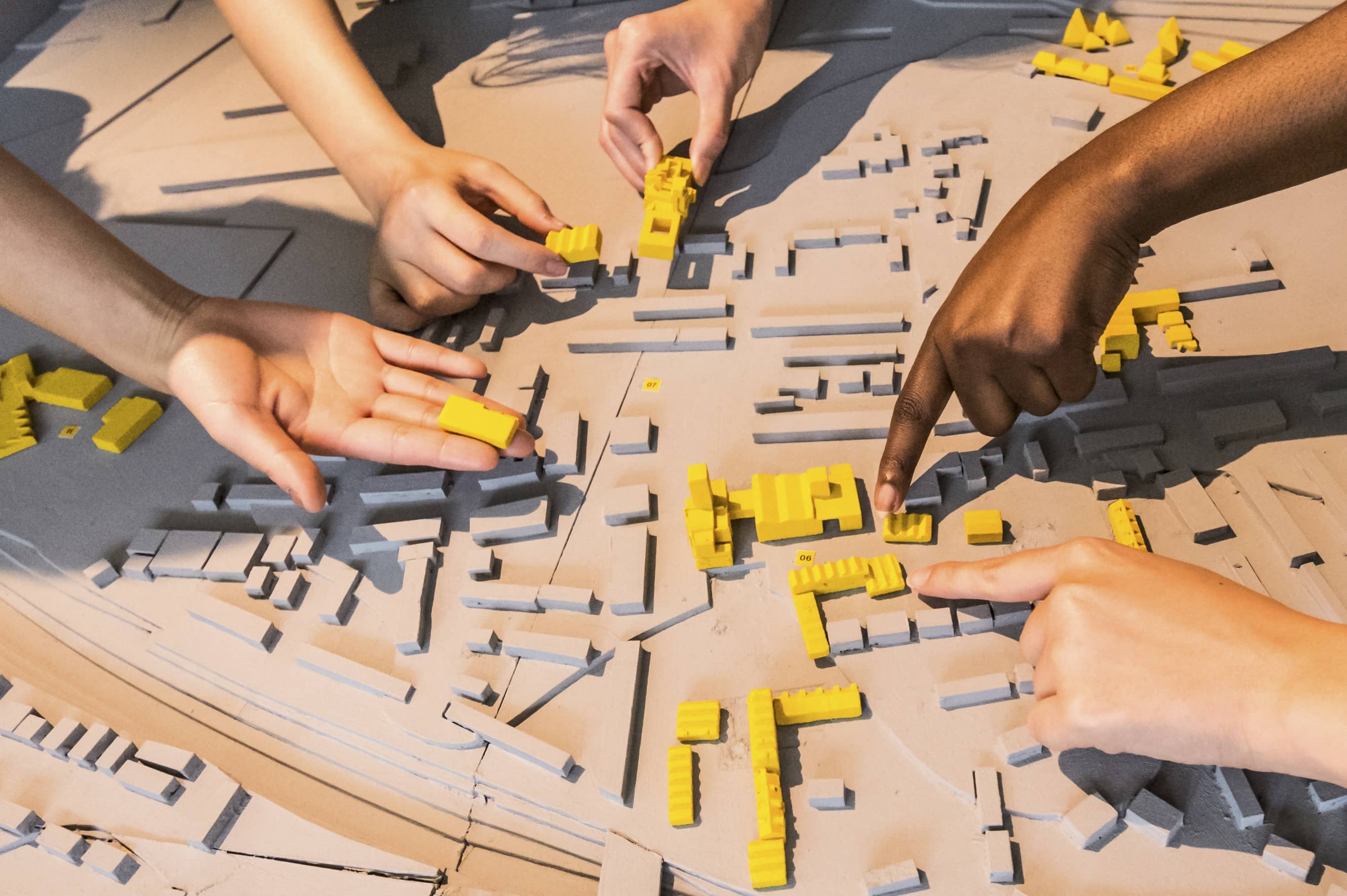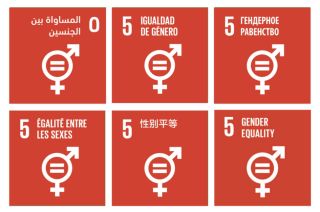
www.buildingsandcities.org/insights/commentaries/planning-toolkits.html
Planning Toolkits for Gender-Sensitive Cities

Specialist toolkits can help the built environment professions to design urban spaces with gender equality
In the past, planning and design decisions have resulted
in creating places that make the lives of women harder than men. Karen Horwood and
Charlotte Morphet (Leeds
Beckett University) discuss the use of toolkits that address gender equality in
town planning. They propose that toolkits
could help to achieve change and inclusivity in processes across all the built
environment professions.
Considering the needs of women in planning
In recent years there has been increasing attention to the extent that women's needs are considered when planning our towns and cities. In the 1990s and early 2000s significant work was undertaken to highlight the ways in which the built environment failed to plan for everyone (Greed 1994; Little 1994; Reeves 2005). More recently, attention to gender issues in urban planning has entered into the mainstream, with Criado-Perez's (2019) influential Invisible Women and Kern's (2020) Feminist City which brings a focus on women and their experiences of the urban environment to a wider audience.
Although the concepts are universal, they need to be acted upon locally. Many successful examples of local implementation exist. Leeds has become a Women Friendly City as part of the UN's Women Friendly City initiative (Women Friendly Leeds 2023) and Glasgow (UK) passed a motion to become a feminist city (Perry 2023). Vienna adopted gender mainstreaming in their approach to planning in the 1990s. More recently Barcelona uses a gendered lens for planning and Lyon has adopted gendered budgeting. Mumbai now has an Advisory Committee on Gender for Mumbai's Development Plan. Nepal established 'The City of Women Laboratory' to explore the inclusion of women in urban development and governance. Monterrey, Mexico introduced a Gender Equality Programme within Urban Development (Dutton et al. 2021).
Beyond individual initiatives, there is a need to shift practice and culture in all building professions to become more gender sensitive. To achieve this, we can look at the toolkits and frameworks that give guidance on how to consider the needs of women or gender sensitivities in practice.
Gender Mainstreaming Toolkits
Women working in urban planning demonstrated how their needs were not being met by existing planning practice (Morphet & Nisancioglu 2021). In response, the Royal Town Planning Institute's (RTPI) Gender Mainstreaming toolkit was developed (Greed et al. 2003). This toolkit gives tangible examples of where planning practice impacts disproportionately on women and provides a series of questions for planners to ask themselves to make their practice more gender sensitive:
- who was involved in the activity?
- who were the people being planned for?
- how are they involved?
- how is the activity reviewed through a gendered lens?
Another toolkit available in the UK is 'Arup Cities Alive' (2022), developed with the University of Liverpool and the United Nations Development Programme. This toolkit considers women's experiences in cities across four themes:
- safety and security
- justice and equity
- health and well-being
- enrichment and fulfilment.
This toolkit outlines a detailed approach to the process from needs analysis to area-wide planning, focusing on organisations' structures and processes, reform and the inclusion of diverse actors. A 12-stage process is suggested to ensure gender is considered throughout, starting with a women's local needs analysis to ensure that a context specific understanding of existing challenges and opportunities is established. Later in the process a task force for gender responsive planning is recommended to ensure different stakeholders are brought into the process. An example of the final stage includes up skilling professionals and advocating for reform to ensure greater longevity.
The Greater London Authority (2022) published guidance focused on making public spaces safer for women. This was aimed at built environment professionals and provides 10 questions across the project lifecycle to enable participative and inclusive practice. It asks whether the project team is gender-informed and diverse and whether data collection processes are inclusive. A more diverse project team allows multiple voices to be heard during the project life cycle, which will contribute to a greater awareness of differing needs. Data collection that is disaggregated by characteristics such as sex, race and disability ensure that decision-making can be informed and shaped with diversity at the forefront. The guidance offers questions rather than answers in recognition that solutions will vary from project to project and as such a shift in the way the process is approached is key.
All these toolkits share a focus on thinking holistically about how people across the range of built environment disciplines can work together to consider gender in decision-making. The processes involved need to be shaped in such a way that enables communication, collaboration and a shared awareness of how gender intersects with the built environment. Rather than dictating outcomes, the toolkits suggest a change to working practices. Planning has a role within this process but also needs the buy-in of other built environment professionals who can shape their own practice.
Mainstreaming equality in planning and beyond
There is a need to ensure that a gendered lens is applied throughout all building professions to achieve a culture where consideration of how the needs of all are met, and action to ensure better outcomes for all are expected and supported. This means ensuring diversity in the people that are involved at all stages of the process is crucial. Success has been achieved by organisations such as Women and Planning, The Black and Minority Ethnic (BAME) Planners Network, Planning Out and the RTPI's Neurodiversity Working Group, who have undertaken work to ensure better representation within the profession. This has resulted in minoritised groups being in decision-making roles and created a culture where diverse voices are able to speak up and be listened to. However, achieving this type of representation is crucial for reasons of justice and fairness (Celis and Childs 2008), but it is not simple to implement . Toolkits may therefore be an effective way to provide a blueprint for how changes to processes and practice can be applied to achieve greater equality across all building professions and help us create more gender-sensitive cities.
References
Arup. (2022). Cities alive: Designing cities that work for women. [Online]. London: Arup. https://www.arup.com/perspectives/publications/research/section/cities-alive-designing-cities-that-work-for-women
Celis, K. & Childs, S. (2008). Introduction: The descriptive and substantive representation of women: New directions. Parliamentary Affairs 61(3) 419-425
Criado-Perez, C. (2019). Invisible Women.London: Chatto and Windus
Dutton J. et al. (2021). Feminist planning and urbanism: Understanding the past for an inclusive future. In: Brears R. (ed) The Palgrave Encyclopedia of Urban and Regional Futures. Cham: Palgrave Macmillan.
Greater London Authority (GLA). (2022). Safety in public space: Women, girls and gender diverse people. London: Mayor of London. https://publica.co.uk/projects-gender-inclusion-and-womens-safety/
Greed, C. (1994). Women and Planning: Creating Gendered Realities. London: Routledge
Greed, C. Davies, L. Brown, C. Duhr, S. & Reeves, D. (2003). Gender equality and plan making: The gender mainstreaming toolkit. London: RTPI. https://www.rtpi.org.uk/media/3518/genderequality-planmaking.pdf
Horwood, K. (2022). Women and planning: Developing the conversation. Town Planning Review. 93(6) pp. 571-573.
Horwood, K., Bicquelet Lock, A., Manns, S., Morphet, C. & Palit, N. (2022). The substantive and descriptive representation of women in planning: Analysis from practice and academia. Town Planning Review, 93(6) pp. 657-675
Kern, L. (2020). Feminist City: Claiming Space in a Manmade World. New York: Verso
Little, J. (1994). Gender Planning and the Policy Process. Oxford: Elsevier.
Morphet, J. & Nisancioglu, S. (2021). Early experiences of women and planning initiatives 1980-1990. Town Planning Review, 93(6), 595-615.
Perry, F. (2023, March/April). Woman in motion: An interview with Holly Bruce. The Planner.
Reeves, D. (2005). Planning for Diversity: Policy and Planning in a World of Difference. London: Routledge
United Nations Human Settlements Programme (UN-Habitat) & Global Utmaning. (2021). Her City: A guide for cities to sustainable and inclusive urban planning and design together with girls. Nairobi: UN-Habitat. https://unhabitat.org/sites/default/files/2021/03/02032021_her_city_publication_low.pdf
Women Friendly Leeds. (2023). Women Friendly Leeds. www.womenfriendlyleeds.org/about
Latest Peer-Reviewed Journal Content
Acceptability of sufficiency consumption policies by Finnish households
E Nuorivaara & S Ahvenharju
Key factors for revitalising heritage buildings through adaptive reuse
É Savoie, J P Sapinski & A-M Laroche
Cooler streets for a cycleable city: assessing policy alignment
C Tang & J Bush
Understanding the embodied carbon credentials of modern methods of construction
R O'Hegarty, A McCarthy, J O'Hagan, T Thanapornpakornsin, S Raffoul & O Kinnane
The changing typology of urban apartment buildings in Aurinkolahti
S Meriläinen & A Tervo
Embodied climate impacts in urban development: a neighbourhood case study
S Sjökvist, N Francart, M Balouktsi & H Birgisdottir
Environmental effects of urban wind energy harvesting: a review
I Tsionas, M laguno-Munitxa & A Stephan
Office environment and employee differences by company health management certification
S Arata, M Sugiuchi, T Ikaga, Y Shiraishi, T Hayashi, S Ando & S Kawakubo
Spatiotemporal evaluation of embodied carbon in urban residential development
I Talvitie, A Amiri & S Junnila
Energy sufficiency in buildings and cities: current research, future directions [editorial]
M Sahakian, T Fawcett & S Darby
Sufficiency, consumption patterns and limits: a survey of French households
J Bouillet & C Grandclément
Health inequalities and indoor environments: research challenges and priorities [editorial]
M Ucci & A Mavrogianni
Operationalising energy sufficiency for low-carbon built environments in urbanising India
A B Lall & G Sethi
Promoting practices of sufficiency: reprogramming resource-intensive material arrangements
T H Christensen, L K Aagaard, A K Juvik, C Samson & K Gram-Hanssen
Culture change in the UK construction industry: an anthropological perspective
I Tellam
Are people willing to share living space? Household preferences in Finland
E Ruokamo, E Kylkilahti, M Lettenmeier & A Toppinen
Towards urban LCA: examining densification alternatives for a residential neighbourhood
M Moisio, E Salmio, T Kaasalainen, S Huuhka, A Räsänen, J Lahdensivu, M Leppänen & P Kuula
A population-level framework to estimate unequal exposure to indoor heat and air pollution
R Cole, C H Simpson, L Ferguson, P Symonds, J Taylor, C Heaviside, P Murage, H L Macintyre, S Hajat, A Mavrogianni & M Davies
Finnish glazed balconies: residents' experience, wellbeing and use
L Jegard, R Castaño-Rosa, S Kilpeläinen & S Pelsmakers
Modelling Nigerian residential dwellings: bottom-up approach and scenario analysis
C C Nwagwu, S Akin & E G Hertwich
Mapping municipal land policies: applications of flexible zoning for densification
V Götze, J-D Gerber & M Jehling
Energy sufficiency and recognition justice: a study of household consumption
A Guilbert
Linking housing, socio-demographic, environmental and mental health data at scale
P Symonds, C H Simpson, G Petrou, L Ferguson, A Mavrogianni & M Davies
Measuring health inequities due to housing characteristics
K Govertsen & M Kane
Provide or prevent? Exploring sufficiency imaginaries within Danish systems of provision
L K Aagaard & T H Christensen
Imagining sufficiency through collective changes as satisfiers
O Moynat & M Sahakian
US urban land-use reform: a strategy for energy sufficiency
Z M Subin, J Lombardi, R Muralidharan, J Korn, J Malik, T Pullen, M Wei & T Hong
Mapping supply chains for energy retrofit
F Wade & Y Han
Operationalising building-related energy sufficiency measures in SMEs
I Fouiteh, J D Cabrera Santelices, A Susini & M K Patel
Promoting neighbourhood sharing: infrastructures of convenience and community
A Huber, H Heinrichs & M Jaeger-Erben
New insights into thermal comfort sufficiency in dwellings
G van Moeseke, D de Grave, A Anciaux, J Sobczak & G Wallenborn
'Rightsize': a housing design game for spatial and energy sufficiency
P Graham, P Nourian, E Warwick & M Gath-Morad
Implementing housing policies for a sufficient lifestyle
M Bagheri, L Roth, L Siebke, C Rohde & H-J Linke
The jobs of climate adaptation
T Denham, L Rickards & O Ajulo
Structural barriers to sufficiency: the contribution of research on elites
M Koch, K Emilsson, J Lee & H Johansson
Disrupting the imaginaries of urban action to deliver just adaptation [editorial]
V Castán-Broto, M Olazabal & G Ziervogel
Nature for resilience reconfigured: global- to-local translation of frames in Africa
K Rochell, H Bulkeley & H Runhaar
How hegemonic discourses of sustainability influence urban climate action
V Castán Broto, L Westman & P Huang
Fabric first: is it still the right approach?
N Eyre, T Fawcett, M Topouzi, G Killip, T Oreszczyn, K Jenkinson & J Rosenow
Social value of the built environment [editorial]
F Samuel & K Watson
Understanding demolition [editorial]
S Huuhka
Data politics in the built environment [editorial]
A Karvonen & T Hargreaves



Latest Commentaries
Decolonising Cities: The Role of Street Naming
During colonialisation, street names were drawn from historical and societal contexts of the colonisers. Street nomenclature deployed by colonial administrators has a role in legitimising historical narratives and decentring local languages, cultures and heritage. Buyana Kareem examines street renaming as an important element of decolonisation.
Integrating Nature into Cities
Increasing vegetation and green and blue spaces in cities can support both climate change mitigation and adaptation goals, while also enhancing biodiversity and ecological health. Maibritt Pedersen Zari (Auckland University of Technology) explains why nature-based solutions (NbS) must be a vital part of urban planning and design.